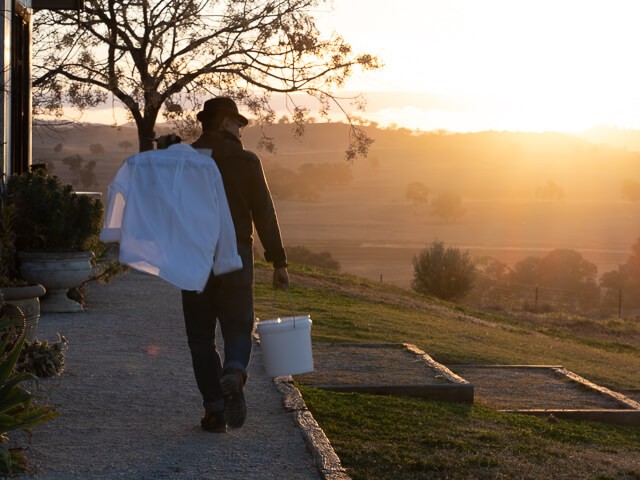Published in Where Guestbook Sydney
Just under three hours northwest of Sydney is the Central Tablelands, a large region, which is a mecca for food and wine, with pristine bushland, heritage colonial towns and a famous open-range zoo. This picturesque region separates the Sydney metropolitan area from the Western Plains and starts at historic Bathurst, moving north to the charming country towns of Mudgee and Orange, before finishing at the regional centre of Dubbo. A set of wheels is the best way to experience the Central Tablelands area and we recommend at least four days to a week to slow down and appreciate this stylish slice of country life.

MuDgEE
Mudgee lies 270km northwest of Sydney on the scenic Castlereagh Highway. Surrounded by winelands, it exudes small town charm in spades. Its grandiose colonial buildings are a legacy of the Gold Rush in the 1850s when Mudgee was the administrative centre of the nearby lucrative goldfields. Today they have been lovingly restored and the economy is fuelled by the new gold – wine. Once pilloried as ‘Mudgee Mud’, today Mudgee wines are lauded, especially for Spanish style varietals, Graciano, Gran Tinto and the new kid on the block, Zinfandel. The most enjoyable way to get from vineyard to vineyard is by bicycle. Mudgee is an emerging bike hub, with bike hire outlets in town and a family-friendly Bike Muster at Easter.
Food is a major preoccupation in these parts. The burgeoning markets, held on the third Saturday of the month in the church grounds, is the place to sample local olive oils, honey and mead, cheese and sourdough. The big event in town is the Mudgee Wine & Food Festival in September, a celebration of local produce.
But there’s more to Mudgee than food and wine. Mudgee is a good launching pad for World Heritage Wollemi National Park, New South Wales’s largest wilderness area and home to the ancient Wollemi Pine tree. Dunns Swamp (or more lyrically, Ganguddy to the local Aboriginals), is the most easily accessed part of the park from Mudgee and is a haven for canoeing, swimming and walking. There are several delightful historic villages nearby including Gulgong, home of Henry Lawson, Australia’s legendary balladeer, with filmset perfect looks and over 130 buildings with National Trust classification.
visitmudgeeregion.com.au, mudgeewine.com.au, bikemuster.com
OraNgE
Accessed via the Mitchell Highway, Orange is as genteel as can be. Named after Prince William of Orange (Netherlands), the early settlers were miners and graziers. Banjo Paterson, Australia’s celebrated bush poet, of The Man from Snowy River fame, was born in Orange, the son of a grazier. Today there is a whiff of old England about Orange, evident in the wide streets dappled with trees, spacious parks and classy eateries.
With an almost monkish devotion to food, Orange is home to three elegant hatted restaurants including creative French eatery, Racine. Look for imaginative dishes such as lamb, goat’s curd, black olive, pea and apple with freekah. The main street is a foodie’s playground with providores, cafés and Ferment, The Orange Wine Centre, which is a good place to get to grips with Orange’s wine scene. Orange produces cool climate wines from over 30 wineries, which are showcased during Orange F.O.O.D. (Food of Orange District) Week in April and Orange Winefest in October. Fringed by fertile farmland, in season you can pick your own cherries, berries and apples, stock up on artisan treats at the farmers’ market or take a cooking class at Orange Regional Cooking School. To work off the kilos walk the City Heritage Trail, which connects 40 historic sites, pan for gold at historic Ophir or enjoy a round of golf at prestigious Duntryleague. For magnificent views drive to the summit of Mount Canobolas, 12km south of Orange. At 1395m Mount Canobolas is the highest peak in the central west, with picnic areas, lookouts and diverse bushland, including sub-alpine forest at the summit. Dust off the walking boots and take one of the seven walking trails on the mountain to the chorus of colourful rosellas, cockatoos and lorikeets.
visitorange.com.au, racinerestaurant.com.au, orangefoodweek.com.au, learntocook.com.au
DuBBO
On the northwestern edge of the Central Tablelands, Dubbo, meaning ‘Red Earth’, in local Aboriginal language, refers to the red ochre traditionally used as body paint. As a large regional centre with a rich pastoral history, it offers a diverse range of attractions, including the acclaimed Taronga Western Plains Zoo. This unique 300-hectare open-range zoo has more than 700 animals, mainly African and Australian favourites. The animals are allowed to roam free, with natural barriers rather than fences, where possible, and visitors can explore the zoo on foot, bike, car or electric safari cart. It’s not every day you come face-to-face with elephants, giraffes or koalas! For more thrills book an Animal Encounter or stay overnight in African-style glamping cabins.
Colonial history and Aboriginal art are also high on Dubbo’s agenda. Don’t miss the multi-million dollar Western Plains Cultural Centre, a cutting-edge centre encompassing an art gallery, museum and exhibition space, with a focus on Aboriginal paintings. Delve back in time at the Old Dubbo Gaol, which recreates 19th century prison life and runs Twilight Tours or the spooky adults-only tour, Beyond the Grave. Not to be outdone by its neighbours, Dubbo also does a line in wine and food, with several nearby wineries and farmers markets twice a month. dubbotourism.com.au, taronga.org.au/taronga-western-plains-zoo, westernplainsculturalcentre.org, olddubbogaol.com.au
